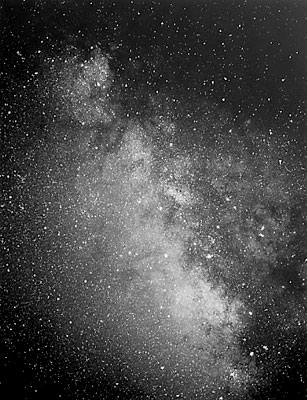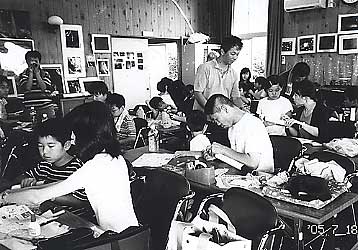• July 26
This was a public viewing day and the observatory was crowded
with a group of about 40 visitors from outside the prefecture. However,
the 60cm reflector, the main telescope of the observatory, was inoperative
and smaller instruments were substituted for viewing.
I photographed star-fields from my own observatory, as I
was not in charge of today's event. I photographed the Milky Way with a
Bronica camera, which I had bought a long time ago. The lens was Nikkor
75mm f/2.8. Having fallen in love with it, I bought this camera. The coma
peculiar to this lens produces a rather uncommon image, in which the broad
end of the fan-shaped image points toward the center. But, overall, the
focused image is quite sharp. I like this camera, particularly because
it has a manual shutter for time exposure.
The camera captured the 9.2-magnitude nova a little west
of a Messier open cluster near the tail of the scorpius. The image indicates
that the 75mm lens may not provide enough resolution to pick out the nova
easily. The Milky Way turned out to be generally overexposed. The nova
was at 8.1 magnitude in a photograph taken on the following day by the
21cm Epsilon telescope. Refer to
Reports from Geisei Observatory, July 27, 2005 for more details.

The summer Milky Way taken by Bronica EC camera
10-minute exposure from 20:30 on July 26, 2005 J.S.T.
TM400 film
It's been fine weather since this morning. We had a regular
"parents-and-children astronomy class". Today's class is the
first of the three-day event and the participants learned to build simple
Kepler telescopes with help from Mr. Okamura, a staff member of the observatory.
The children experienced the excitement of seeing the stars
through the telescope they had built by themselves. They must have felt
an emotion and joy which differs from that of viewing the stars through
a large telescope, all programmed by adults.
It is heart-warming to see parents and children working together
on the same project. I sincerely hope that this kind of activity interests
children in science and encourages them to get themselves absorbed in healthy
activity.
It was fortunate that they were able to see the moon and
Jupiter under clear skies. "I can see craters!". "I can
see three moons of Jupiter!" Their enthusiasm continued endlessly.
The 60cm reflector is out of action at the moment and Mr.
Nakauchi of Kochi Prefecture Life-long Learning Department (which manages
the observatory)is in negotiation with Goto Optical Company for urgent
repairs. It seems that the main pulse motor is shot. Goto says it will
take about 2 months to make a new replacement motor and, in the worst,
observations at Geisei involving precise measurements will not be conducted
during this period. We have large numbers of visitors around this time
of year, however, and public viewing and classes will continue as planned.
(The first photograph below shows the participants making telescopes. In
the second photograph they take their telescopes out to observe.)

Parents and children building their own telescopes
The parents-and-children astronomy class.
(Geisei Observatory Learning Center)

The participants are enjoying the night sky through their home-made telescopes.
We had a public viewing day at the observatory today. It
was a hot day following the end of the rainy season and about 30 visitors
gathered.
At first, Mr. Oba conducted a planetarium show directly operated
from a computer. Later, the visitors went into the 60cm reflector dome
to view lunar craters and Jupiter's cloud belts. However, the drive motor
for the 60cm telescope stopped working during the observing. The trouble
seemed to be different from what we had experienced in the past. I wondered
if the telescope had lived out its life after 20 years of operation and
felt a tinge of sadness. This is a very serious problem and observation
at Geisei will be interrupted for a while.
There were thunder clouds towering in the clear, deep-blue
sky indicative of the end of the rainy season. In the night sky I felt
a touch of autumn from the glow of the northern Milky Way. I mounted a
50-year-old renowned Retina Vc onto the 21cm telescope and photographed
the Milky Way around Cassiopeia. Rodenstock-Heligon 50mm f/2 lens challenged
the starry sky for the first time. This lens is known to bring out subtlety
and depth in landscape photography. You will appreciate the intricately
detailed images.

The Milky Way around Cassiopeia
10-minute exposure from 2:10 on July 18, 2005
Retina IIIc + Rodenstock-Heligon 50mm f/2 lens
TM400 film
The sky has been completely clear since this morning. The
rainy season in the Shikoku area seems to be over.
I came to the observatory late last night. It has been some
time since the last observation at Geisei. During the early evening there
were a lot of clouds with no wind, but it gradually cleared up later at
night. While searching the early morning sky, I saw Perseus's Double Cluster
and the Pleiades in Taurus. They were so pretty that I felt completely
refreshed. I saw the Pleiades for the first time this year. It was a familiar
lovely sight. If my memory serves me correct, Comet Ikeya 2 was discovered
in the Hyades in Taurus in early July, 1964. The magnitude was 7 in my
15cm reflector.
Professional astronomers continue to discover faint comets
well into July. I observed C/2005 N1, one of the brighter of them this
morning.
2005UT RA (2000.0) Decl. m1
July14.71493 04 11 21.39 +42 50 26.7 14.5 372
14.72371 04 11 24.04 +42 50 46.6 14.3 372
14.75000 04 11 32.25 +42 51 47.3 14.2 372
During the third observation thin clouds drifted into the
low eastern sky, which may have somewhat affected the accuracy of the results.
However, the overall results were good. They deviated about 70" from
the IAU's preliminary parabolic orbit. It appeared small and diffuse with
the firm nucleus.
Hot weather continues. The Pleiades rises a little higher
every day in the eastern sky. We will feel the autumn coolness in the air
at night by the time of the Perseid meteor shower in August. The Milky
Way, as magnificent as I saw from the summit of Mauna Kea, is now over
Geisei.
• July 7
This is the Tanabata star festival day. Around this time
of year the rainy season is not completely over yet and clear starry nights
are rather rare. On this year's Tanabata day, however, we were able to
see Vega (the weaver) overhead, although thin clouds veiled the sky. I
can remember that, when I was a child, my mother would cheerfully celebrate
Tanabata festival setting up two bamboo trees in the courtyard decorated
with numerous strips of "tanzaku" paper(1). The night sky was
always clear on the festival day and the tanzaku made rustling sounds in
night breezes, which sounded like the purling sound of the Milky Way river.
As the night progressed, I felt the arrival of autumn in the cool night
breezes. It is because Tanabata was celebrated on July 7 on the lunar calendar
in those days.
I have a fond memory of listening to the old tales told by
the elderly under a starry sky, while sitting on a bench cooling myself
with a fan after taking a hot bath. Among their tales, the story of kitsunebi(2)
or ignis fatuus (friar's lantern) running through the northern hill was
the most scary. The famous scientist-essayist Torahiko Terada wrote a similar
story in his essay as his account of witnessing kitsunebi.
(1) Small strips of color paper on which personal wishes or poems are written.
(2) Kitsunebi is literally "fox fire" and the cause of this phenomenon is uncertain. It is not the same as the English word "foxfire" and is closer to ignis fatuus.




